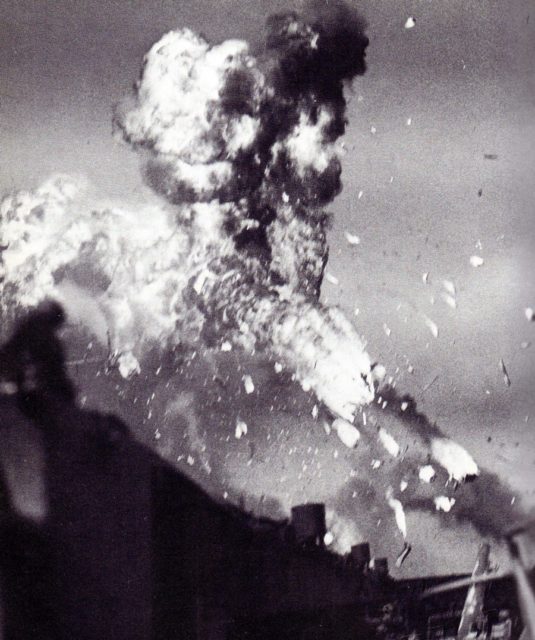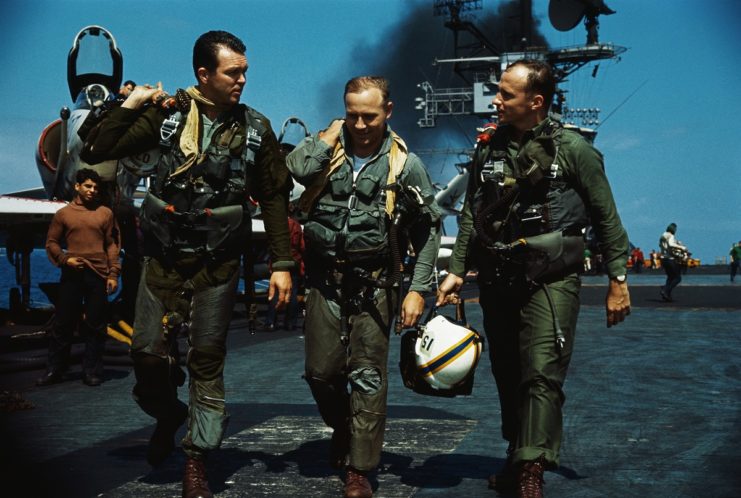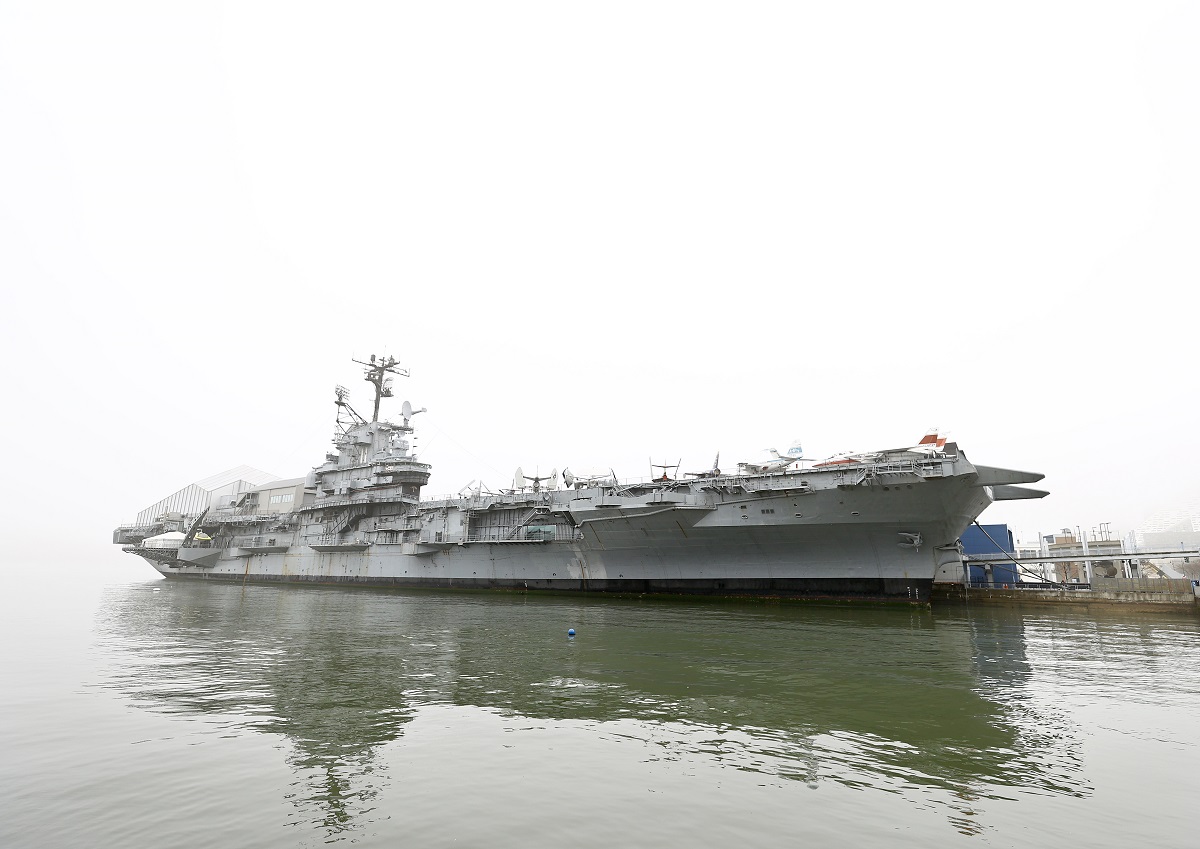The USS Intrepid was an Essex-class aircraft carrier built during WWII. Initially operating in the Pacific Theatre, Intrepid would end up serving a wild 30-year long career, which saw her hit by a number of kamikaze attacks, commissioned twice, rebuilt, serve through the Vietnam War, and fish three astronauts from the sea.
Despite her incredible career Intrepid was known for her bad luck, and as a result, received the nicknames “Decrepit” and “the Dry I”. After retiring – for the second time – she was moored up at Pier 86 in New York, and is now the Intrepid Air and Space Museum.
Laid down on December 1, 1941, Intrepid was one of 24 Essex-class carriers, out of an original order of 32. The Essex-class was the 20th century’s most numerous class of capital ships and remained the backbone of the US Navy’s carrier fleet throughout the war until the arrival of the supercarriers in the 1960s.
Thanks to the termination of the Washington Naval Treaty, these 266 m (872 ft) long carriers were able to carry much better armor, increasing their durability. When empty the ships displaced 30,000 tons and were bulky enough to receive newer and heavier aircraft such as the F6F Hellcat and SB2C Helldiver. A port-side elevator served as a backup to the two center elevators in the event they jammed.
The Essex-class were also armed to the teeth to defend against air attacks. Over seventy 40 mm Bofors cannons, twelve 5 inch guns with proximity-fused air-burst shells, and air and surface-search radar provided a formidable shield against incoming aircraft.
During WWII it became increasingly obvious that aircraft carriers were the new kings of the seas. Battleships could unleash incredible firepower against other ships situated 10 to 20 miles away, but aircraft carriers could send a swarm of aircraft carrying bombs and torpedoes against targets hundreds of miles away. With many recognizing their might, they became high-value targets in the Pacific War.
WWII

Intrepid spend two years under construction before launching from Newport News, Virginia in August 1943. She completed her shakedown cruise and headed straight into the thick of combat in the Pacific in January of 1943.
Her first mission was to support the Allies’ ongoing island-hopping campaign, which by this point had reached the Gilbert and Marshall Islands. After her aircraft helped wreak havoc on Kwajalein Atoll, Intrepid’s next task was to assist in raids on Truk Lagoon. Intrepid and other carriers devastated Japanese forces in Truk, but on the night of 17–18 February, just weeks after she first saw combat, the mighty carrier was hit by a torpedo from a Japanese B6N “Jill” bomber.
The hit damaged Intrepid’s stern and jammed her rudder while in a port turn. To counter the turn Captain Thomas Sprague reversed the starboard screw and doubled the portside. In addition, the crew fashioned an old-school sail out of canvas to help steer her to Pearl Harbor for repairs.
Intrepid was back in combat seven months later and supported the Marines landing on Peleliu. Following this, the carrier was involved in the Battle of Leyte Gulf, which saw a major naval clash between the US and Japan near the Philippines. Despite being massively outgunned, Japan assembled a force of nine battleships, nineteen cruisers, and four carriers.
The Japanese had also brought along one of their most powerful weapons, the battleship Musashi. Displacing 80,000 tons and armed with enormous 18-inch guns, the Musashi, along with her sister ship Yamato was the biggest and most powerful battleship ever built.
During the Battle of Leyte Gulf, aircraft – including ones from Intrepid – harassed Musashi for hours. The fearsome battleship shot down four of Intrepid’s aircraft but was hit by an estimated 17 bombs and 19 torpedoes. She finally capsized on 24 October 1944.
Shortly after this success Intrepid came under intense attacks from Japanese kamikaze aircraft; the first of which struck one of the carrier’s ports anti-aircraft positions. On November 25 a Zero crashed into the ship and set it ablaze. Before this fire could be extinguished another Zero slammed into the flattop’s flight deck and started a fire in one of its hangers. More than 60 men died in the attack, and so once again the wounded ship headed back to Pearl Harbor for repairs.
She was back in action in early 1945 and was able to support the bloody landings at Okinawa. Bad luck would strike again though, as a fourth kamikaze hit the ship, causing another fierce fire below decks. Intrepid sailed back to Pearl Harbor for repairs for the third time. When the war ended USS Intrepid traveled to Japan to assist in the occupation.
Post-WWII

In February of 1947 Intrepid was decommissioned. However, she managed to escape the scrapyard fate of so many other ships when she received a major overhaul in 1952, that allowed her to handle the newer, heavy jet aircraft coming into service.
In 1954, with the modifications complete, she was recommissioned.
In the 1960s the Intrepid was tasked with a new type of mission – one related to space. On May 24, 1962, astronaut Scott Carpenter landed in the Caribbean about 250 miles off course from his intended landing zone. A couple of hours after he splashed down USS Intrepid fished Carpenter out of the ocean.
Three years later astronauts Virgil Grissom and John Young from the Gemini 3 mission needed to be recovered from the ocean. Helicopters from Intrepid collected the men, while the carrier itself lifted the capsule from the water with a crane.
The WWII era flattop then fought in its second major war, this time in Vietnam. Now carrying jets unlike anything seen in the 1940s, the ship’s aircraft carried out missions over the country, with one even managing to shoot down a MiG-17.
More From Us: US Navy Sells Aircraft Carriers to Scrap Dealers for a Cent Each
After three deployments to Vietnam, the USS Intrepid was approaching the end of its career. On 15 March 1974 she was decommissioned for the second, and final time, with the Navy planning on scrapping her.
Fortunately, the ship that had seen so much was saved from the scrapyard by a campaign, and she was turned into a museum ship instead. Moored up at Pier 86 in New York, the Intrepid Air and Space Museum is home to some of the rarest and most interesting aircraft ever made, including an SR-71 Blackbird and a Concorde.
